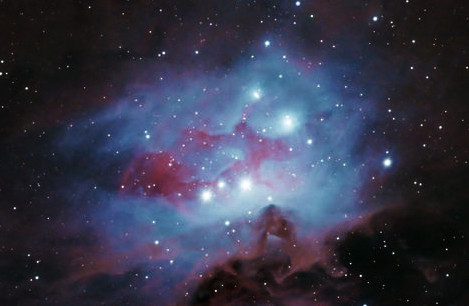Messier 8, Messier 20 and Messier 21
Constellation: Sagittarius
This image depicts a region of the constellation Sagittarius, that is rich in celestial objects. In contains Messier 8, Messier 20 and Messier 21, as well as NGC 6544. Link to interactive sky chart.
Messier 8 is a giant molecular cloud classified both as an emission nebula and and H II region. South of Messier 8 is the globular cluster NGC 6544.
Messier 20 is an H II star-forming region. The object is an unusual combination of an open cluster of stars, an emission nebula (the relatively dense, reddish-pink portion), a reflection nebula (the blue portion), and a dark nebula (the apparent ‘gaps’ in the former that cause the trifurcated appearance, also designated Barnard 85).
Messier 21 is an open cluster located about 3900 Ly from Earth.
Dates:
Data acquired remotely in May 2023 using Martin’s equipment. The image consists of two panes.
His telescope is located in Australia (Observatory: Heaven’s second mirror, NSW).
Colour palette is SHO.
Telescope & Mount:
SharpStar 140mm (F4.8) on a Software Bisque Paramount ME II mount.
Imaging:
Camera: SBIG STXL16200, FW8G
Data:
Nebula:
Antlia Ha: 49x600s
Antlia O3: 50x600s
Antlia S2: 42x600s
Stars:
Antlia R: 30x60s
Antlia G: 30x60s
Antlia B: 43x60s
Total integration time: 25h 13′
Several objects are visible in this image:
Messier 8, also known as the Lagoon nebula and NGC 6523, is a giant molecular cloud. Within the nebula is the open cluster NGC 6530.

Left is Messier 20, also known as the Trifid nebula or NGC 6514.
Right is Messier 21, also known as Webb’s Cross or NGC 6531, is an open cluster located to the north of Messier 20.




